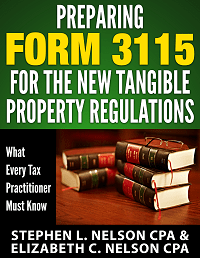 Okay, you may not know this yet. But a 2013 change in the accounting rules for repair and maintenance expenditures (specifically, Treasury Regulation Section 1.263) has your poor accountant pulling out his or her hair.
Okay, you may not know this yet. But a 2013 change in the accounting rules for repair and maintenance expenditures (specifically, Treasury Regulation Section 1.263) has your poor accountant pulling out his or her hair.
Accordingly, I’m going to summarize here how the new rules work for small businesses–and then explain in plain language how you and your accountant need to react.
With a little up-front planning and some attention to detail over the remainder of 2014, the new regulations don’t have to create a huge headache for you. Or jack your taxes.
The New Repair Regulations in a Nutshell
So here’s the new rule (which isn’t very different from the old rule): You can’t simply expense all of your repair and maintenance expenses. No way.
Rather, you need to capitalize any repair or maintenance expenditures which “better” or “restore” a property or asset, as well as any expenditures which adapt an asset or property so it’s again “like new” or can be used for something different.
Now here’s a quick, practical observation: What the IRS has done with these new regulations is very explicitly say what you and I must do in the future is basically what we should have been doing in the past.
I mention the preceding awkward point because much of what’s been going on with repair and maintenance deductions is that businesses and investors have simply aggressively deducted amounts.
In the past, for example, many small businesses and their accountants simply “deducted first” and then (maybe) “asked questions later.”
Oftentimes, businesses and their accountants rather aggressively set capitalization limits that needed to be exceeded in order for the accountants to worry about capitalizing some expenditure and then depreciating it over time.
Similarly, repairs and maintenance expenditures were often, well, aggressively written off if someone, somewhere in the accounting process could find a semi-decent rationale for immediately expensing the outlay.
But now, the rules explicitly say this kind of quick-and-dirty accounting is wrong. The rules say that if you or I want to deduct some expenditure by calling the amount repairs or maintenance, we need to make sure we’re not bettering, restoring or adapting an asset or property.
To sum up the situation, then, many small businesses and investors probably need to dial down their immediate expensing of repair and maintenance costs.
But, fortunately, the regulations offer up three safe harbors that should help many small businesses minimize their tax impact.
De Minimis Safe Harbor
So the first safe harbor to know about is the “de minimis safe harbor” which says that as long as you meet three requirements, you’re okay to simply write off your nickel and dime repair or maintenance expenditures.
Here are the three requirements:
- You expense the repairs and maintenance expenditure in your internal accounting records (so inside QuickBooks for example).
- You either don’t pay more than $2,500, or the thing you spent money on lasts a year or less.
- You have a formal accounting policy (and have had it at least since the beginning of the year) that says you roll this way.
Example: If you go out and buy five $2,500 tablet computers, you can probably use the de minimis safe harbor to write off the computers because each costs $2,500 or less as long as that’s your “policy.”
Example: If you go out and buy five $2,600 computers, you can’t use the de minimis safe harbor to write off the computers because each costs more than $2,500.
Note: Different “de minimis” rules apply for bigger businesses with audited financial statements. For example, in a larger business, the dollar limit equals $5,000 and the formal accounting policy must be in writing.
Routine Maintenance Safe Harbor
Okay, here’s another safe harbor you want to know about: the “routine maintenance” safe harbor.
The routine maintenance safe harbor says that money you spend to keep a property in reasonable, efficient condition isn’t capitalized. These maintenance costs, by the way, should occur more than once during the years you maintain the thing. (That’s the meaning of “routine”, right?)
But when the repairs and maintenance you’re expending money for are “routine” you deduct. You don’t capitalize.
Example: If you have the oil changed every six months in a delivery truck, you can use the routine maintenance safe harbor because you’ll obviously change the oil regularly—and many times over the life of a vehicle.
Example: If you pay (say) $5,000 to have the air conditioning unit repaired in a big truck, you probably can’t use the routine maintenance safe harbor because you’ll probably only make this big repair once.
Small Taxpayer Safe Harbor
Small businesses and most individuals also get the benefit of a “small taxpayer” safe harbor.
This third safe harbor says that if the amounts you’ve spent on repairs and maintenance for building property (includes condos and co-ops) fall under the lesser value of $10,000 or two percent of the item’s original cost, you can just expense the repairs or maintenance.
If the dollars are relatively small, in other words, you don’t have to capitalize.
An important point: In order to qualify as a “small taxpayer” your average annual gross income (based on last three years) needs to fall under $10,000,000.
Example: You qualify as a small taxpayer and spend $9,000 repairing and maintaining a $500,000 building. Because $9,000 is less than $10,000 and less than two percent of $500,000, you can expense the entire $9,000.
A Plug for Our e-Book about the New Regulations
With the issuance of Revenue Procedure 2015-20 (which appeared on February 13, 2015) many small businesses may not need to worry about filing 3115 forms for the the TRPs. (See here for our post about the revenue procedure.)
However if you are a tax accountant and have clients that need or want to prepare 3115s for the new TPRs–perhaps to deal with late partial dispositions or to obtain audit protection for their accounting method changes–you may interested in our ebook on the subject.
We’ve prepared a short, slightly-longer-than-50-pages e-book. This downloadable e-book, which a tax practitioner can probably skim through in less than an hour, explains how the new regulations change the way small taxpayers need to do their accounting for tangible property deductions.
The e-book also describes a straight-forward approach to complying with new regulations with a minimum amount of fuss and handwringing, and it includes sample, completed 3115 forms for the three most common accounting method change requests small taxpayers will need to make… (We’ve also thrown in a sample accounting policy which should help a small taxpayer stay in compliance in the future.)
For $100, you can purchase and immediately download this e-book. Click the button here to make your purchase:
Money Back Guarantee
And an important note: We’re providing a money-back guarantee… if you don’t find our e-book saves you several hours of time and lets you easily prepare 3115s (for which you should be able to charge some multiple of the price you pay for the book) just email use and ask for a refund.

Will this affect home-based businesses or business use of home?
Technically yes. In practice, I would think the safe harbors mentioned probably mean home office users don’t need to worry much.
What if I already filed a 2014 return? Should I amend the return? Can I just file the form 3115? Do I have to amend the return even if the accounting change causes no change to my retained earnings?
In order to get automatic consent, you needed to file the 3115 with the original return.
Here’s an irs website page that provides this information and a bit more detail: http://www.irs.gov/Businesses/Small-Businesses-&-Self-Employed/Tangible-Property-Final-Regulations#Whenandhowdoyouchange
Read the paragraphs under the heading: When and how do you change a method of accounting to use the final regulations?
We have purchased your ebook which has been helpful. Have you completed a 3115 with a DCN 7? If so could you provide a sample?
Hi Drenda,
We don’t have example 3115s for every DCN… sorry. Note that we were practically constrained by file size limits. Ugh.
Steve